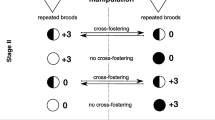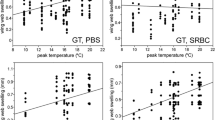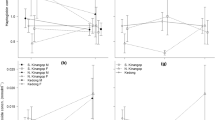Abstract
In seasonally fluctuating environments, timing of reproduction is a crucial determinant of fitness. Studies of birds show that late breeding attempts generally result in offspring of lower reproductive value, with lower recruitment and long-term survival prospects. Several proximate mechanisms, including a seasonal decline of immune system functioning, may lead to a seasonal decline of offspring fitness. We investigated seasonal variation in offspring quality by subjecting first- and second-brood chicks of a sexually size dimorphic species, the European starling Sturnus vulgaris, to an immune challenge with a bacterial endotoxin (LPS), and evaluated their growth and physiological response in terms of total plasma antioxidant capacity (TAC), concentration of reactive oxygen metabolites and hematocrit. LPS challenge did not affect chick growth or oxidative status. However, hematocrit of second-brood chicks was higher in LPS chicks compared to controls. Body mass halfway through the rearing period (days 8–9 post-hatching), TAC and hematocrit were lower among second- vs. first-brood chicks. Interestingly, sexual dimorphism in body mass at days 8–9 post-hatching markedly differed between broods, first-brood males being 4.7% and second-brood males 22.7% heavier than their sisters, respectively. Pre-fledging mortality occurred among second-brood chicks only and was strongly female-biased. Our findings suggest that starling chicks, even if in poor conditions, are little affected by a bacterial challenge, at least in the short-term. Moreover, our study indicates that sex differences in body size, possibly mediated by sex-specific maternal investment in egg size, may heavily impact on pre-fledging survival in a different way in the course of the breeding season, resulting in sex-specific seasonal decline of offspring fitness. Finally, we suggest that levels of circulating antioxidants should be regarded among the proximate causes of the association between timing of fledging and long-term survival in avian species.



Similar content being viewed by others
References
Alonso-Alvarez C, Bertrand S, Devevey G, Gaillard M, Prost J, Faivre B, Sorci G (2004) An experimental test of the dose-dependent effect of carotenoids and immune activation on sexual signals and antioxidant activity. Am Nat 164:651–659
Badyaev AV (2002) Growing apart: an ontogenetic perspective on the evolution of sexual size dimorphism. Trends Ecol Evol 17:369–378
Berthouly A, Cassier A, Richner H (2008) Carotenoid-induced maternal effects interact with ectoparasite burden and brood size to shape the trade-off between growth and immunity in nestling great tits. Funct Ecol 22:854–863
Bertrand S, Criscuolo F, Faivre B, Sorci G (2006) Immune activation increases susceptibility to oxidative tissue damage in Zebra Finches. Funct Ecol 20:1022–1027
Bhattacharyya J, Biswas S, Datta AG (2004) Mode of action of endotoxin: role of free radicals and antioxidants. Curr Med Chem 11:359–368
Bize P, Devevey G, Monaghan P, Doligez B, Christe P (2008) Fecundity and survival in relation to resistance to oxidative stress in a free-living bird. Ecology 89:2584–2593
Boncoraglio G, Martinelli R, Saino N (2008) Sex-related asymmetry in competitive ability of sexually monomorphic barn swallow nestlings. Behav Ecol Sociobiol 62:729–738
Bonisoli-Alquati A, Martinelli R, Rubolini D, Saino N (2008) Sex-specific effects of albumen removal and nest environment manipulation on barn swallow nestlings. Ecology 89:2315–2324
Bonisoli-Alquati A, Boncoraglio G, Caprioli M, Saino N (2011) Birth order, individual sex and sex of competitors determine the outcome of conflict among siblings over parental care. Proc R Soc B 278:1273–1279
Bonneaud C, Mazuc J, Gonzalez G, Haussy C, Chastel O, Faivre B, Sorci G (2003) Assessing the cost of mounting an immune response. Am Nat 161:367–379
Bourgeon S, Guindre-Parker S, Williams TD (2011) Effects of sibling competition on growth, oxidative stress, and humoral immunity: a two-year brood-size manipulation. Physiol Biochem Zool 84:429–437
Brinkhof MWG, Cavé AJ, Hage FJ, Verhulst S (1993) Timing of reproduction and fledging success in the Coot Fulica atra: evidence for a causal relationship. J Anim Ecol 62:577–587
Brinkhof MWG, Cave AJ, Perdeck AC (1997) The seasonal decline in the first-year survival of juvenile coots: an experimental approach. J Anim Ecol 66:73–82
Casagrande S, Dell’Omo G, Costantini D, Tagliavini J (2006) Genetic differences between early- and late-breeding Eurasian kestrels. Evol Ecol Res 8:1029–1038
Catoni C, Peters A, Martin Schaefer H (2008) Life history trade-offs are influenced by the diversity, availability and interactions of dietary antioxidants. Anim Behav 76:1107–1119
Chin EH, Love OP, Clark AM, Williams TD (2005) Brood size and environmental conditions sex-specifically affect nestling immune response in the European starlings Sturnus vulgaris. J Avian Biol 36:549–554
Christe P, de Lope F, Gonzalez G, Saino N, Møller AP (2001) The influence of environmental conditions on immune responses, morphology and recapture probability of nestling house martins (Delichon urbica). Oecologia 126:333–338
Clark AB, Wilson DS (1981) Avian breeding adaptations: hatching asynchrony, brood reduction, and nest failure. Q Rev Biol 56:253–277
Clutton-Brock TH (1988) Reproductive success. University of Chicago Press, Chicago
Clutton-Brock TH, Albon SD, Guinness FE (1985) Parental investment and sex differences in juvenile mortality in birds and mammals. Nature 313:131–133
Cordero PJ, Vinuela J, Aparicio JM, Veiga JP (2001) Seasonal variation in sex ratio and sexual egg dimorphism favouring daughters in first clutches of the spotless starling. J Evol Biol 14:829–834
Costantini D (2008) Oxidative stress in ecology and evolution: lessons from avian studies. Ecol Lett 11:1238–1251
Costantini D, Dell’Omo G (2006a) Environmental and genetic components of oxidative stress in wild kestrel nestlings (Falco tinnunculus). J Comp Physiol B 176:575–579
Costantini D, Dell’Omo G (2006b) Effects of T-cell-mediated immune response on avian oxidative stress. Comp Biochem Physiol A 145:137–142
Costantini D, Møller AP (2009) Does immune response cause oxidative stress in birds? A meta-analysis. Comp Biochem Physiol A 153:339–344
Costantini D, Carello L, Fanfani A (2010) Relationships among oxidative status, breeding conditions and life-history traits in free-living Great Tits Parus major and Common Starlings Sturnus vulgaris. Ibis 152:793–802
Cotton PA, Wright J, Kacelnik A (1999) Chick begging strategies in relation to brood hierarchies and hatching asynchrony. Am Nat 153:412–420
Cramp S (1998) The complete birds of the western Palearctic on CD-ROM. Oxford University Press, Oxford
Crick HQP, Gibbons DW, Magrath RD (1993) Seasonal changes in clutch size in British birds. J Anim Ecol 62:263–273
Dubiec A, Cichoñ M (2001) Seasonal decline in health status of Great Tit (Parus major) nestlings. Can J Zool 79:1829–1833
Fair J, Whitaker S, Pearson B (2007) Sources of variation in haematocrit in birds. Ibis 149:535–552
Feare CJ, Burham SE (1978) Lack of nest site tenacity and mate fidelity in the starling. Bird Study 25:189–191
Griffiths R (1992) Sex-biased mortality in the lesser black-backed gull Larus fuscus during the nestling stage. Ibis 134:237–244
Griffiths R, Double MC, Orr K, Dawson RJ (1998) A DNA test to sex most birds. Mol Ecol 7:1071–1075
Grindstaff JL (2008) Maternal antibodies reduce costs of an immune response during development. J Exp Biol 211:654–660
Grindstaff JL, Hasselquist D, Nilsson JK, Sandell M, Smith HG, Stjernman M (2006) Transgenerational priming of immunity: maternal exposure to a bacterial antigen enhances offspring humoral immunity. Proc R Soc B 273:2551–2557
Grüebler MU, Naef-Daenzer B (2008) Fitness consequences of pre- and post-fledging timing decisions in a double-brooded passerine. Ecology 89:2736–2745
Grüebler MU, Naef-Daenzer B (2010) Fitness consequences of timing of breeding in birds: date effects in the course of a reproductive episode. J Avian Biol 41:282–291
Halliwell B, Gutteridge JMC (1999) Free radicals in biology and medicine. Oxford University Press, Oxford
Hendry AP, Day T (2005) Population structure attributable to reproductive time: isolation by time and adaptation by time. Mol Ecol 14:901–916
Hochachka W (1990) Seasonal decline in reproductive performance of song sparrows. Ecology 71:1279–1288
Hochachka W, Smith JNM (1991) Determinants and consequences of nestling condition in song sparrows. J Anim Ecol 60:995–1008
Horak P, Zilmer M, Saks L, Ots I, Karu U, Zilmer K (2006) Antioxidant protection, carotenoids and the costs of immune challenge in greenfinches. J Exp Biol 209:4329–4338
Iwasa Y, Levin SA (1995) The timing of life history events. J Theor Biol 172:33–42
Janeway CA, Travers P (1999) Immunobiology: the immune system in health and disease, 4th edn. Current Biology, London
Klomp H (1970) The determination of clutch size in birds. Ardea 58:1–124
Krist M (2011) Egg size and offspring quality: a meta-analysis in birds. Biol Rev 86:692–716
Lack D (1947) The significance of clutch size. Ibis 89:302–352
Lack D (1954) The natural regulation of animal numbers. Clarendon, Oxford
Lee KA, Martin LB II, Wikelski MC (2005) Responding to inflammatory challenges is less costly for a successful avian invader, the house sparrow (Passer domesticus), than its less-invasive congener. Oecologia 145:244–251
Littell RC, Milliken GA, Stroup WW, Wolfinger RD, Schabenberger O (2006) SAS for mixed models, 2nd edn. SAS, Cary
Lochmiller RL, Deerenberg C (2000) Trade-offs in evolutionary immunology: just what is the cost of immunity? Oikos 88:87–98
López-Rull I, Salaberria C, Gil D (2010) Seasonal decline in egg size and yolk androgen concentration in a double brooded passerine. Ardeola 57:321–332
López-Rull I, Celis P, Salaberria C, Puerta M, Gil D (2011) Post-fledging recruitment in relation to nestling plasma testosterone and immunocompetence in the spotless starling. Funct Ecol 25:500–508
Magrath RD (1991) Nestling weight and juvenile survival in the blackbird, Turdus merula. J Anim Ecol 60:335–351
Mainwaring M, Dickens M, Hartley IR (2010) Sexual dimorphism and growth trade-offs in Blue Tit Cyanistes caeruleus nestlings. Ibis 153:175–179
Merino S, Potti J (1998) Growth, nutrition, and blowfly parasitism in nestling pied flycatchers. Can J Zool 76:936–941
Merino S, Møller AP, de Lope F (2000) Seasonal changes in cell-mediated immunocompetence and mass gain in nestling barn swallows: a parasite-mediated effect? Oikos 90:327–332
Møller AP (2002) North Atlantic Oscillation (NAO) effects of climate on the relative importance of first and second clutches in a migratory passerine bird. J Anim Ecol 71:201–210
Møller AP, Erritzøe J (1996) Parasite virulence and host immune defense: host immune response is related to nest reuse in birds. Evolution 50:2066–2072
Møller AP, Saino N (2004) Immune response and survival. Oikos 104:299–304
Møller AP, de Lope F, Saino N (2004) Parasitism, immunity, and arrival date in a migratory bird, the barn swallow. Ecology 85:206–219
Møller AP, Arriero E, Lobato E, Merino S (2009) A meta-analysis of parasite virulence in nestling birds. Biol Rev 84:567–588
Monaghan P, Metcalfe NB, Torres R (2009) Oxidative stress as a mediator of life history trade-offs: mechanisms, measurements and interpretation. Ecol Lett 12:75–92
Moreno J, Merino S, Sanz JJ, Arriero E, Morales J, Tomas G (2005) Nestling cell-mediated immune response, body mass and hatching date as predictors of local recruitment in the pied flycatcher Ficedula hypoleuca. J Avian Biol 36:251–260
Morishita TY, Aye PP, Ley EC, Harr BS (1999) Survey of pathogens and blood parasites in free-living passerines. Avian Dis 43:549–552
Naef-Daenzer B, Widmer F, Nuber M (2001) Differential post-fledging survival of great and coal tits in relation to their condition and fledging date. J Anim Ecol 70:730–738
Norris K, Evans MR (2000) Ecological immunology: life history trade-offs and immune defense in birds. Behav Ecol 11:19–26
Norte AC, Sheldon BC, Sousa JP, Ramos JA (2009) Environmental and genetic variation in body condition and blood profile of great tit Parus major nestlings. J Avian Biol 40:157–165
Oddie KR (2000) Size matters: competition between male and female great tit offspring. J Anim Ecol 69:903–912
Owen-Ashley NT, Wingfield JC (2007) Acute phase responses of passerine birds: characterization and seasonal variation. J Ornithol 148:583–591
Owen-Ashley NT, Turner M, Hahn TP, Wingfield JC (2006) Hormonal, behavioral, and thermoregulatory responses to bacterial lipopolysaccharide in captive and free-living white-crowned sparrows (Zonotrichia leucophrys gambelii). Horm Behav 49:15–29
Parsons J (1975) Seasonal variation in the breeding success of the herring gull: an experimental approach to pre-fledging success. J Anim Ecol 44:553–573
Perrins CM (1970) The timing of birds’ breeding seasons. Ibis 112:242–255
Pinxten R, Eens M, Verheyen RF (1990) Intermediate clutches in the Starling (Sturnus vulgaris): replacement clutches, additional clutches of polygynous males or late first clutches? J Ornithol 131:141–150
Potti J, Moreno J, Merino S, Frias O, Rodriguez R (1999) Environmental and genetic variation in the haematocrit of fledgling pied flycatchers Ficedula hypoleuca. Oecologia 120:1–8
Price K, Ydenberg RC (1995) Begging and provisioning in broods of asynchronously-hatched yellow-headed blackbird nestlings. Behav Ecol Sociobiol 37:201–208
Råberg L, Stjernman M, Nilsson J-Å (2005) Sex and environmental sensitivity in blue tit nestlings. Oecologia 145:496–503
Richner H, Oppliger A, Christe P (1993) Effect of ectoparasites on reproduction in great tits. J Anim Ecol 62:703–710
Romano A, Rubolini D, Caprioli M, Boncoraglio G, Ambrosini R, Saino N (2011) Sex-related effects of an immune challenge on growth and begging behavior of barn swallow nestlings. PLoS One 6:e22805
Rowe L, Ludwig D, Schluter D (1994) Condition, and the seasonal decline of avian clutch size. Am Nat 143:698–722
Rubolini D, Romano M, Bonisoli-Alquati A, Saino N (2006) Early maternal, genetic and environmental components of antioxidant protection, morphology and immunity of yellow-legged gull (Larus michahellis) chicks. J Evol Biol 19:1571–1584
Saino N, Calza S, Møller AP (1997) Immunocompetence of nestling barn swallows in relation to brood size and parental effort. J Anim Ecol 66:827–836
Saino N, Caprioli M, Romano M, Boncoraglio G, Rubolini D, Ambrosini R, Bonisoli-Alquati A, Romano A (2011) Antioxidant defenses predict long-term survival in a passerine bird. PLoS One 6:e19593
Sheldon BC, Verhulst S (1996) Ecological immunology: costly parasite defences and trade-offs in evolutionary ecology. Trends Ecol Evol 11:317–321
Simon A, Thomas DW, Bourgault P, Blondel J, Perret P, Lambrechts MM (2005) Between-population differences in nestling size and hematocrit level in blue tits (Parus caeruleus): a cross-fostering test for genetic and environmental effects. Can J Zool 83:694–701
Slagsvold T, Sandvik J, Rofstad G, Lorentsen Ö, Husby M (1984) On the adaptive value of intraclutch egg size variation in birds. Auk 101:685–697
Slagsvold T, Amundsen T, Dale S (1995) Costs and benefits of hatching asynchrony in Blue Tits Parus caeruleus. J Anim Ecol 64:563–578
Sorci G, Soler JJ, Møller AP (1997) Reduced immunocompetence of nestlings in replacement clutches of the European magpie (Pica pica). Proc R Soc B 264:1593-1598
Soszynski D, Krajewska M (2002) Time-course of changes in plasma nitric oxide following lipopolysaccharide and turpentine injection in rats. J Therm Biol 27:387–391
Uller T (2006) Sex-specific sibling interactions and offspring fitness in vertebrates: patterns and implications for maternal sex ratios. Biol Rev 81:207–217
Verboven N, Verhulst S (1996) Seasonal variation in the incidence of double broods: the date hypothesis fits better than the quality hypothesis. J Anim Ecol 65:264–273
Verboven N, Visser ME (1998) Seasonal variation in local recruitment of great tits: the importance of being early. Oikos 81:511–524
Verhulst S, Nilsson JÅ (2008) The timing of birds’ breeding seasons: a review of experiments that manipulated timing of breeding. Phil Trans R Soc Lond B 363:399–410
Whittingham MJ, Stephens PA, Bradbury RB, Freckleton RP (2006) Why do we still use stepwise modelling in ecology and behaviour? J Anim Ecol 75:1182–1189
Wilk T, Dubiec A, Cichoń M (2006) Seasonal decline in cell-mediated immunity of collared flycatcher Ficedula albicollis nestlings: does the sex of offspring matter? J Ornithol 148:199–205
Williams TD (1994) Intraspecific variation in egg size and egg composition in birds: effects on offspring fitness. Biol Rev 68:35–59
Zuur AF, Ieno EN, Walker NJ, Saveliev AA, Smith GM (2009) Mixed effects models and extensions in ecology with R. Springer, New York
Acknowledgements
We thank A. De Pasquale, S. Fabbri, R. Mantovani, P. F. Micheloni, D. Piacentini, M. Rusche, F. Santostefano, M. Spreafico and S. Tomasini for their technical support and two anonymous referees for constructive comments. Partial financial support was provided by MIPAF-DG Sviluppo Rurale, Infrastrutture e Servizi (SVIRIS X).
Ethical standards
This research was undertaken (capture and experimental treatments) under the combined prescriptions of Art. 4 (1) and Art. 7 (5) of the Italian law 157/1992, which regulates studies on wild bird species.
Conflicts of interest
The authors declare that they have no conflict of interest.
Author information
Authors and Affiliations
Corresponding author
Additional information
Communicated by J. Graves
Electronic supplementary material
Below is the link to the electronic supplementary material.
ESM 1
(DOC 26.0 kb)
Rights and permissions
About this article
Cite this article
Serra, L., Pirrello, S., Caprioli, M. et al. Seasonal decline of offspring quality in the European starling Sturnus vulgaris: an immune challenge experiment. Behav Ecol Sociobiol 66, 697–709 (2012). https://doi.org/10.1007/s00265-012-1318-3
Received:
Revised:
Accepted:
Published:
Issue Date:
DOI: https://doi.org/10.1007/s00265-012-1318-3




